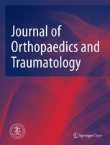Official Journal of SIOT
Italian Society of Orthopaedics and Traumatology
Evaluation of lower limb kinetics during gait, sprint and hop tests before and after anterior cruciate ligament reconstruction
The purpose of this study was to evaluate the functional status prior to and at different times after anterior cruciate ligament reconstruction (ACLR), and to analyze the changes in the kinetic patterns of the...
